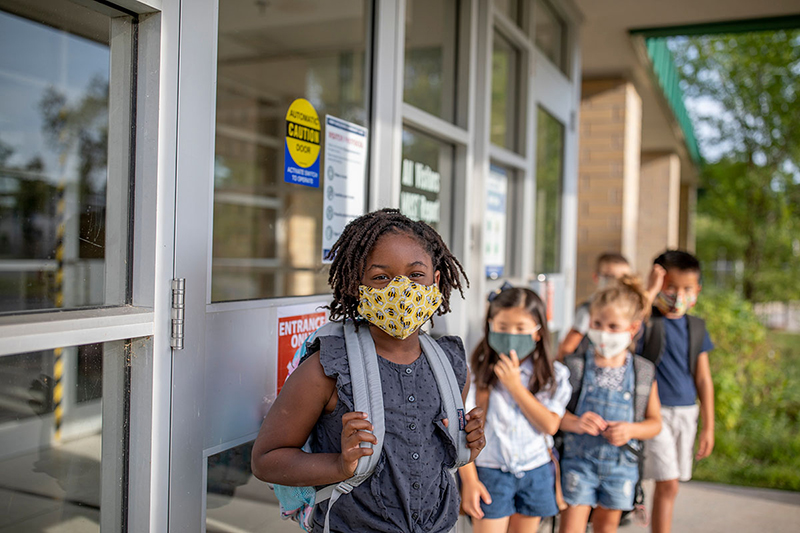
Joint Blog by William T. Riley, Ph.D., OBSSR Director, and Diana W. Bianchi, M.D., NICHD Director, on Children’s Health Day
Today (October 4) is Children’s Health Day, and the pandemic has made these challenging times for the health of our children. Children have missed in-person learning as well as health-promoting resources, such as school lunch programs, during the pandemic. Despite the best efforts of school systems to provide virtual learning, it is estimated that our children are coming into this school year about a half-year behind , more so for those who are more vulnerable to COVID-19, including children with intellectual and developmental disabilities or who come from disadvantaged communities.
The re-opening of in-person learning in most U.S. school systems this year should begin to address these learning deficits, but it also raises concerns that children, parents, and teachers are at a higher risk of getting COVID-19. Parents and teachers know well from prior experience that schools are a breeding ground for cold and flu viruses that spread among children and to their parents and teachers. The difference with SARS-CoV-2, the virus that causes COVID-19 disease, is that it can lead to more serious illness. Children are less likely than adults to develop COVID symptoms, but a small percentage can develop multi-system inflammatory syndrome (MIS-C). Even if they are asymptomatic, infected children can carry the virus home to their parents and grandparents, who are at greater risk of severe COVID illness.
To address these and other child health concerns, various social and behavioral science organizations have initiated a coordinated effort (#SBS4Kids) to describe the role the social and behavioral sciences can play in addressing these child health concerns and empower our children to thrive in these challenging times. At their core, the strategies to reduce the risk of getting COVID are behaviors conducted in social systems and contexts, and the social and behavioral sciences can provide important information to teachers, parents, and children considering the risks and benefits of these behaviors.
Since the beginning of the pandemic, wearing face masks has been shown to be a simple, low-cost method to reduce the spread of SARS-CoV-2 among adults, and there is increasing evidence that face masks are effective at reducing transmission in schools. A recent CDC study of 520 U.S. counties found that those without school mask requirements had larger increases in pediatric COVID-19 case rates after the start of school, compared to counties that had school mask requirements (34.85 cases per 100,000 children and adolescents aged <18 years per day vs. 16.32 cases per 100,000 per day).
But are there risks of our children wearing face masks? Some parents are concerned that wearing masks will negatively impact their child’s mental health and well-being, but prior to COVID, there was little opportunity to study the risks from healthy children wearing masks regularly, so there are very little data from the United States to address this question. The limited research available since the pandemic began indicates that there are no significant respiratory effects from mask wearing during rest or mild activity . In addition, three studies (https://papers.ssrn.com/sol3/papers.cfm?abstract_id=3899140
, https://pure.mpg.de/rest/items/item_771569_9/component/file_1527244/content
, and https://journals.plos.org/plosone/article?id=10.1371/journal.pone.0243708
) have examined the issue of masks and social and emotional development and conclude that the impact is minimal. Their findings suggest that children can successfully adapt to wearing masks, be able to have successful social interactions, and reasonably interpret emotional cues by those wearing masks. No evidence exists that in cultures where mask wearing is relatively common, children are impaired either socially or in recognizing faces or emotions. Additional research is needed on the impact of mask wearing on the social and emotional development of children, especially those with intellectual/developmental disabilities, and whether masks affect children’s interactions with people they are less familiar with.
Regular COVID testing in schools is another way to reduce the risk of transmission. Early identification of school children or staff infected by the virus allows schools and families to reduce contact between infected and uninfected individuals to control the spread. Through the RADx-UP initiative, NIH has accelerated COVID testing adoption in underserved and vulnerable populations. The RADx-UP Return to School Diagnostic Testing Initiative will provide evidence to better understand the social, behavioral, and ethical implications of COVID testing in school settings. These research projects, involving more than 600,000 students in 13 states are ongoing, but preliminary results from the first phase of projects were presented at an August workshop. These findings suggest that COVID testing is feasible and acceptable across a range of school settings and populations and that increased testing is associated with decreased days of quarantine of students and staff. Testing, in combination with other mitigation strategies, appears to help keep students in school. NIH and partners have developed a K-12 Playbook as part of its WhenToTest.org resources to provide school leaders with the information they need to implement a school testing program.
Children are likely to feel anxious and worried in these challenging times. Their regular school and home routines have been disrupted. Although we still have much to learn about COVID and the behaviors that reduce the risk of getting the disease, the social and behavioral sciences have considerable research experience with managing child anxiety. A recent paper summarized these strategies as they apply to COVID: a) acknowledge the child’s concerns, b) provide a safe place to discuss feelings, c) maintain routines and empower children by giving choices, and d) manage adult anxiety, as children can pick up anxiety from their caregivers, parents, and teachers.
Children’s Health Day recognizes the care and guidance children need to grow strong and healthy—physically, psychologically, and socially. The COVID-19 pandemic has made providing this care and guidance challenging, but scientific research, including social and behavioral science research, is increasingly providing the knowledge caregivers need to make informed decisions about their child’s health and to empower children to thrive in challenging times.
 BACK TO TOP
BACK TO TOP